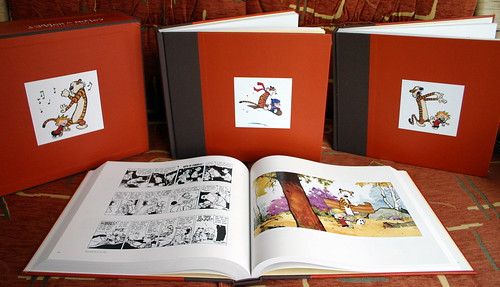Perhaps no artistic work has had as great an impact on my mind and worldview as Calvin and Hobbes, Bill Watterson's magnificent comic strip about an imaginative six-year-old boy and his pet tiger. As soon as school was out and water fight season began, it was once again time to go to the library and check out every Calvin and Hobbes anthology I could get my hands on.
 |
| And now I have it all. |
The basic plot of Calvin and Hobbes covers the daily life of Calvin and his imaginary tiger, Hobbes, who only he sees as a real tiger and not a stuffed animal. Calvin has a very active imagination that often lands him in trouble, whether he is daydreaming instead of paying attention or turning it towards mischief. Hobbes is a foil to Calvin, often advising him against his more foolish adventures, providing a counterpoint or another perspective to Calvin's philosophical musings, and frequently fighting with him. Both characters are extremely well-developed and have many different sides.
The strip started in 1985 and ran until 1995. I actually never read it in the comic section of the newspapers, and I don't know how I even became aware of it. But for the ten years it ran, it was consistently excellent. It features wonderful, intelligent writing that is usually hilarious, but at other times can be profound and have a lot of emotional depth, such as when Calvin finds a dead bird and muses on the fragility of life, or when he loses Hobbes and can't find him. The deep, cerebral writing is complimented by the incredible illustration. Calvin's world is seldom limited to a few talking heads - it's full of surreal landscapes and styles. It's very detailed, and there are many full page color strips.
 |
| I love the duplicator story. |
These styles frequently surface when Calvin imagines he is one of his alter-egos. As the intrepid explorer Spaceman Spiff, he is often captured by aliens when he crash lands on rocky desert planets, to be tortured with homework, math problems, or bath time. Then there's Tracer Bullet, a hard-boiled detective who only trusts his .38 special and his hip flask. His world is inspired by the shadowed back alleys of film noir. But Calvin can just as easily imagine himself as a dinosaur (or my favorite, a tyrannosaurus in an F-14), an ant, a living skeleton, or a two-dimensional boy as flat as a sheet of paper. Possibly the boldest, most unique strip features Calvin imagining himself as a malevolent god of the underworld.
I credit Calvin and Hobbes with introducing me to philosophy, for better or worse. This has been the most significant impact the strip had on me - after all, I went on to major in it. Calvin and Hobbes talk about such philosophically rich topics as ethics, meaning and purpose, mortality, humanity's place in nature, and whether or not a god exists. It was Calvin and Hobbes that first showed me that these were open questions worth pondering.
The thing about Calvin and Hobbes that sets it above and beyond all other comic strips is that there is not a single panel or storyline where Bill Watterson is phoning it in. It remains consistently wonderful for all ten glorious years. There are new ideas in every panel. It never becomes stale or repetitious, and unlike many long-running series, the quality never deteriorates. It's the project of one devoted artist, given the freedom to create, and pour out his good soul on the page. Humanity is richer for it.

No comments:
Post a Comment